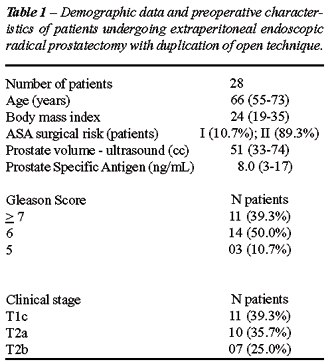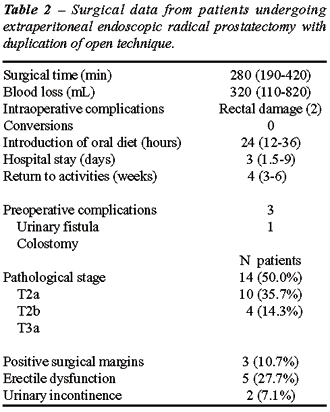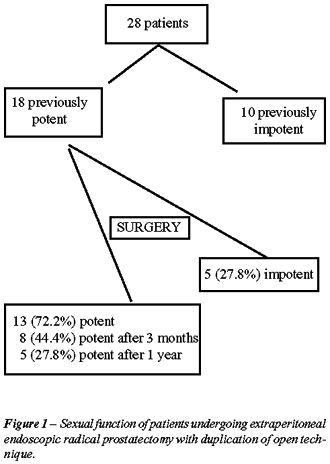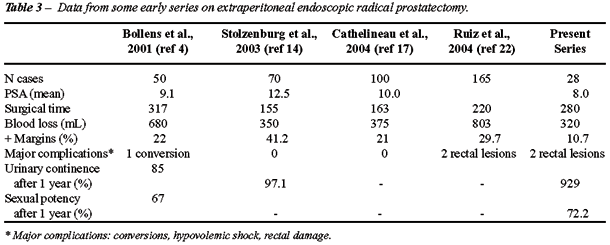PRELIMINARY
EXPERIENCE WITH EXTRAPERITONEAL ENDOSCOPIC RADICAL PROSTATECTOMY THROUGH
DUPLICATION OF THE OPEN TECHNIQUE
(
Download pdf )
M. TOBIAS-MACHADO, MARCO T. C. LASMAR, JIMMY J. A. MEDINA, PEDRO H. FORSETO JR, ROBERTO V. JULIANO, ERIC R. WROCLAWSKI
Section of Urology, ABC Medical School, Santo Andre, Sao Paulo, SP
ABSTRACT
Objective:
To describe surgical and functional results with extraperitoneal laparoscopic
radical prostatectomy with duplication of the open technique, from the
experience obtained in the treatment of 28 initial cases.
Materials and Methods: In a 36-month period,
we prospectively analyzed 28 patients diagnosed with localized prostate
cancer undergoing extraperitoneal laparoscopic radical prostatectomy.
Results: Mean surgical time was 280 min,
with mean blood loss of 320 mL. As intraoperative complications, there
were 2 rectal lesions repaired with laparoscopic suture in 2 planes. There
was no conversion to open surgery. Median hospital stay was 3 days, with
return to oral diet in the first post-operative day in patients. As post-operative
complications, there were 3 cases of extraperitoneal urinary fistula.
Two of these cases were resolved by maintaining a Foley catheter for 21
days, and the other one by late endoscopic reintervention for repositioning
the catheter. Five out of 18 previously potent patients evolved with erectile
dysfunction. The diagnosis of prostate cancer was confirmed in all patients,
with focal positive margin occurring in 3 cases. During a mean follow-up
of 18 months, 2 patients presented increased PSA, with no clinical evidence
of disease.
Conclusion: Laparoscopic radical prostatectomy
is a laborious and difficult procedure, with a long learning curve. Extraperitoneal
access is feasible, and it is possible to practically duplicate the principles
of open surgery. The present technique can possibly offer advantages in
terms of decreased blood loss, preservation of erectile function and prevention
of positive margins.
Key
words: prostatic neoplasms; prostatectomy; retroperitoneum; endoscopy
Int Braz J Urol. 2005; 31: 228-35
INTRODUCTION
Early
experiences with laparoscopic radical prostatectomy were developed by
transperitoneal approach. The surgery was first reported by Schuessler
et al. in 1992, but technical difficulties prevented the diffusion of
its practical application (1). In 1998, Guillonneau & Vallencien (2)
introduced the technique of descending laparoscopic radical prostatectomy
with transperitoneal access, which was reproduced by other services. According
to the authors, the initial access to seminal vesicles and ligation without
section of the venous complex were essential technical modifications that
made the technique’s standardization and feasibility of the laparoscopic
technique easier.
Raboy et al. (3) described the first report
of extraperitoneal laparoscopic radical prostatectomy (ELRP). Except for
the initial dissection of seminal vesicles, the employed technique followed
the principles of the French technique, by sectioning the venous complex
and the urethra at the final step of prostatic ablation. Bollens et al.
(4) described the first series with a larger number of cases using this
technique. In Brazil, laparoscopic radical prostatectomy has been developed
in a few centers, being almost exclusively performed by transperitoneal
approach.
The present work aims to demonstrate the
feasibility of performance, as well as to describe the initial results
of the laparoscopic extraperitoneal technique, using the terms classically
described by Walsh (5).
MATERIALS AND METHODS
Between
February 2001 and February 2004, we studied 28 patients with clinically
localized prostate adenocarcinoma, diagnosed by digital rectal examination,
PSA and ultrasound-guided prostate biopsy. Mean age was 66 years (55-73),
with mean body mass index of 24 (19-35). Twenty-five (89.3%) had ASA surgical
risk II and 3 patients were ASA I (10.7%). Two patients had previously
undergone transurethral resection of the prostate, 3 had a history of
inguinal herniorrhaphy and another 3 had undergone previous surgery with
access to the abdominal cavity.
Tumor staging through abdominal and pelvic
computerized axial tomography and bone scintigraphy was performed when
the serum level of prostate specific antigen (PSA) was higher than 10
ng/mL or when Gleason score was higher than or equal to 7. Patients with
localized disease were selected.
Mean prostate volume as obtained by transrectal
ultrasonography was 51 g (33-74). Mean PSA in this series was 8.0 ng/mL
(3-17 ng/mL). Clinical stage was T1c in 11 patients (39.3%), T2a in 10
patients (35.7%) and T2b in 7 patients (25%).
Among the entire sample, 11 patients (39.3%)
presented Gleason score 7 or higher, 14 patients (50%) had Gleason 6,
and 3 patients (10.7%) had Gleason 5 (Table-1).

Laparoscopic pelvic lymphadenectomy was
performed when PSA was higher than 10 ng/mL and in patients with Gleason
score above 7.
We have described surgical time, blood loss,
intraoperative complications, conversion rate, hospital stay, time until
returning to oral diet, convalescence period, post-operative complications
and histopathological data of the specimen.
Patients were divided into 2 groups in order
to assess the learning curve. The first twenty patients formed the first
group and the remaining 8 the second group. Patients were followed up
on an outpatient basis and assessed at 7, 14 and 30 days following discharge
from hospital, and then every 3 months during the first 2 years, with
clinical examination and PSA measurement. Following this period, follow-up
was biannual. Mean follow-up was 18 months.
Mean blood loss was obtained by estimating
the amount of blood that was aspired during the procedure.
Potency was assessed through the capacity
of maintaining penile rigidity sufficient for sexual intercourse (Item
5 from IIEF). Pre-operatively, 10 patients (35.7%) had erectile dysfunction
while 18 patients (64.3%) had preserved erectile function. In order to
assess continence, we considered the criteria proposed by Turk et al.
(6) and the time to recovery of continence.
All patients were operated at a Brazilian
teaching institution by a single surgeon, who was familiar with extraperitoneal
access, and was aided by an assistant with expertise in laparoscopy and
a training resident doctor for controlling the camera. The protocol was
started after previous experience of the surgeon in assisting transperitoneal
laparoscopic radical prostatectomy in 30 patients.
The adopted surgical technique was performed
through 5 ports, through extraperitoneal space, practically duplicating
all steps used in conventional open radical prostatectomy (7). All patients
received prophylaxis for venous thrombosis with low molecular weight heparin
up to 48 hours following surgery and mobilization in bed after the first
24 hours. Penrose drain was used in all patients, being removed when the
output was lower than 100 cc in 24 hours.
RESULTS
Results
are summarized in Table-2.

Mean surgical time was 280 minutes (190-420).
In the first group, mean surgical time was 340 minutes (290-420). Mean
time for prostate ablation was 200 minutes (170-220) and mean time for
vesicourethral anastomosis was 140 minutes (80-160). In the second group,
mean surgical time was 220 minutes (190-260 min) with mean time for prostate
ablation being 140 minutes (90-160 min) and 80 minutes (45-110) for vesicourethral
anastomosis. Laparoscopic obturator lymphadenectomy was performed in 8
patients with mean additional time of 42.5 minutes (35-50).
Mean blood loss was 320 mL (110-820). The
patient that lost 820 mL of blood was the second in the series and required
transfusion during surgery. Mean blood loss for the first and the second
groups was respectively 500 and 140 mL.
Among intraoperative complications, there
were 2 rectal lesions, which were laparoscopically sutured in 2 planes
of 3-0 polyglactin. The complications occurred in the first group. There
was no conversion to open surgery in this series.
Analgesia was offered with paracetamol and
ketoprofen during the first 24 hours and, following this period, only
if the patient complained of pain. Nine 9 (35.7%) patients require re-administration
of ketoprofen. Only 3 (10.7%) patients used opioids due to more significant
pain.
Mean time until restitution of oral diet
was 24 hours (12-36 hours).
Patients had a median hospital stay of 3
days (1.5-21).
On the seventh postoperative day, a cystography
was performed and the Foley catheter was removed after confirming that
there was no extravasation of urine. If any urine escape persisted, a
new cystography was performed on the 14th post-operative day. Patients
were discharged from hospital with the Foley catheter. Mean period of
catheter maintenance was 11 days in the first group and 7 days in the
second one.
Of the 2 cases presenting rectal lesion,
one required reoperation for loop colostomy on the 4th postoperative day.
Extraperitoneal urinary fistulas occurred in 3 patients, with 2 cases
being resolved by maintaining the Foley catheter for 21 days. The third
case presented high-output urinary fistula, where we observed loosening
of the vesicourethral anastomosis due to improper positioning of the balloon.
This case required endoscopic repositioning of the catheter, with resolution
within 4 days from the intervention.
Mean volume of the removed specimen was
44 g (31-76) and the histological diagnosis of prostate adenocarcinoma
was confirmed in all patients. Pathological stage was T2a in 14 patients
(50%), T2b in 10 patients (35.7%), T3 in 4 patients (14.3%). Three patients
with T3 stage showed focal involvement in the lateral margins. Local or
systemic clinical recurrence was not evidence in the study period. Pathological
result for patients undergoing lymphadenectomy was negative to neoplasia
in all patients. Two patients with pT3 stage had biochemical recurrence
with PSA levels of 1.0 and 1.2 ng/mL 6 and 18 months following surgery,
and were rescued by external radiotherapy. There was no event leading
to the suspicion of clinical recurrence.
Functional
Results
Fourteen patients (50%) showed complete
urinary continence until the third month. On the sixth month, another
8 (28.6%) patients were continent. When assessing the remaining patients
after 12 months, 4 (14.3%) of those who used 2 day pads and one night
pad gained continence. Thus, after one year, 92.9% of the patients were
completely continent.
Of the 2 (7.1%) incontinent patients, 1
was diagnosed with stenosis of the vesicourethral anastomosis and underwent
endoscopic treatment, with good results concerning urethral permeability.
One patient is still incontinent using 4 day pads and 2 night pads and
currently has a surgery planned in order to place an artificial sphincter.
The preservation of the neurovascular bundle
was performed bilaterally when PSA was lower than 10 ng/mL or when no
lateral nodule was palpable on the digital rectal examination. Of the
18 patients with pre-operative potency, 2 presented intraoperative macroscopic
features of extracapsular tumor, which prevented preservation of the nervous
bundle. The patient was considered as definitely impotent when he was
not able to achieve erection, both spontaneously or with the use of oral
or intracavernous drugs, within a 1-year period.
Eight patients (44.4%) recovered potency
up to the third month and another 5 (27.7%) recovered their potency within
one year. Among the 13 potent patients, 6 required inhibitors of type
5 phosphodiesterase in order to maintain an adequate sexual intercourse.
The remaining five (27.7%) patients, where
the use of oral medication or intracavernous injections was not effective
within 1 year following the surgery, have surgical plans for placing a
penile prosthesis (Figure-1).

COMMENTS
Recently,
laparoscopic radical prostatectomy has been introduced aiming to decrease
operative morbidity, while keeping the functional and oncological features
of conventional technique (1).
Laparoscopic technique offers advantages,
especially concerning the access to deeper organs that are surrounded
by bony structures, where the surgical field is too limited for open surgical
maneuvers. It allows better viewing due to magnification and selective
illumination of the structures, thus increasing the accuracy of dissection
and favoring more delicate technical maneuvers. Therefore, the potential
for preserving neurovascular and muscular structures is increased (8).
Robotic assistance, when available, allows better stabilization of image,
reducing surgical time and refining the confection of the vesicourethral
anastomosis. (9).
Some authors have demonstrated that laparoscopic
radical prostatectomy provides functional and oncological results that
are comparable with the open technique, however with significant decrease
in blood transfusion rate, shorter hospital stay and faster recovery (8,10).
Guillonneau et al. in 2002, in a series of 567 patients, reported that
82.9% did not present complications, stating that this access has lower
morbidity than open retropubic surgery (10). Subsequently, the same authors
on the following year, now with 1000 patients, concluded that the laparoscopic
radical prostatectomy presents satisfactory results concerning tumor control
and biochemical recurrence, in addition to being comparable to the open
technique in terms of follow-up and results (11).
In 2002, Salomon et al. showed in their
work that, after one year, laparoscopic prostatectomy resulted in urinary
continence in 90% of patients and preservation of potency in 58.8% and
up to 83.8% in the subgroup of patients under 60 years old (12). Rozet
et al. found similar results in 2004, with the extraperitoneal laparoscopic
approach (13).
The strictly extraperitoneal laparoscopic
radical prostatectomy has gained higher acceptance worldwide. It combines
the benefits of the laparoscopic approach (less painful, lower morbidity,
faster recovery, better cosmetic effect) with the advantages of the open
retropubic surgery. It reduces the risks of damaging intraperitoneal organs,
prolonged adynamic ileus, intracavitary tumor spread, as well as bleeding
or urine extravasations into the peritoneal cavity. Some authors also
believe that it allows better dissection of the neurovascular, as demonstrated
in other series (14,15).
One limitation of the extraperitoneal access
is the reduced working place for manipulating the forceps, especially
when performing aspiration or when there is peritoneal perforation. The
majority of difficulties are overcome with training and adaptation to
the reduced working place by the surgeon, as well as with the proper withdrawing
and exposure of structures by the assistance.
The majority of centers that use extraperitoneal
access employ an antegrade technique. According to this technique’s
adepts, the position of the camera and working forceps in relation to
the prostate would promote greater difficulties for performing the surgery
by retrograde access. With the approached used in the present study, the
proximal retraction of the catheter by the assistant allows the elevation
of the prostate apex and proper visualization of the retroprostatic space,
as occurs in the open technique.
Though CO2 absorption is slightly higher
in the extraperitoneal approach, no clinically significant adverse hemodynamic
or respiratory effects have been found, when compared with the transperitoneal
approach (16).
The intraoperative and oncological results
of transperitoneal and antegrade extraperitoneal laparoscopic radical
prostatectomy were compared by Cathelineau et al. (17), who considered
them equivalent. Though the surgical time was significantly shorter in
extraperitoneal approach, these authors concluded that the selection of
access should depend on the surgeon’s expertise and training. Erdogru
et al. (18) verified this equivalence as well, recommending the extraperitoneal
approach in particular for cases of obesity, previous abdominal surgery
and requirement of concomitant inguinal hernia repair.
In the present study, the technique of endoscopic
radical prostatectomy was totally extraperitoneal and duplicated all the
steps of Walsh’s technique, differing from other techniques reported
in the literature. In 2003, Dubernard et al. (19) published an extraperitoneal
approach characterized by retrograde dissection of the prostate, releasing
the retroprostatic space immediately after the ligation of the dorsal
vein complex and urethral sectioning. The technique employed in our work
differs from the one described by those authors due to control of “back
flow” and ligation of the postero-lateral pedicle of the prostate
with polymer clips. The dissection of the neurovascular bundle is performed
in retrograde and antegrade directions, similarly to the technique described
in 2004 by Su et al. (20). Additionally, the vesicourethral anastomosis
is performed with a continuous suture forming 2 hemicircumference as described
by Van Velthoven et al., thus reducing the learning curve and providing
greater safety as for the anastomosis’ final results (21).
The surgical time obtained in this work
was comparable to other world series on preliminary experience (4,6).
We have also observed a decrease of 120 minutes in mean total surgical
time in the last cases, with the possibility of further reductions as
the learning curve is overcome.
Blood loss was lower in this sample than
in some other series from the literature (4,17), with low transfusion
rate. This fact can result from the familiarity with already known steps
from open surgery technique, in addition to using clips in the prostate
pedicles (Table-3).

Analgesia and hospital stay were similar
to other results reported in the literature (4,6,15).
The most serious complication in this sample
was rectal damage, probably related to the initial retroprostatic dissection
and the learning curve.
Post-operative complications were urinary
fistulas, however they had no major repercussion on the general status
and were easily resolved in all patients, advantages that are attributed
to the extraperitoneal approach. The occurrence of subcutaneous emphysema
is quite frequent, however its clinical repercussion is not significant,
if there is proper intraoperative anesthetic management, with good hydration
and hyperventilation in order to avoid hypercarbia.
In relation to oncological control, the
extraperitoneal approach seems to offer the same early oncological results,
with shorter surgical time. Ruiz et al. (22) in a comparative series of
trans- and extraperitoneal laparoscopic prostatectomies observed that
oncological control and positive margins were similar, though cases operated
by extraperitoneal access had been preoperatively classified as more aggressive.
Our initial impression is that it is possible
to reduce the index of positive margins in the learning curve when compared
with other series of laparoscopic radical prostatectomy. We believe that
the technique described in this study offers clearer visualization of
the prostate contour, since the prostate is fixed to the pelvic floor
only by its lateral pedicles at the end of the procedure. The reduced
rate of positive surgical margins seem to be an advantage with this technique,
however, the small number of cases and the preoperative selection of patients
for this approach do not allow a definitive conclusion.
Functional control, as characterized by
continence, showed no major differences when compared with other world
series (4,15). However, Eden et al. reported that urinary continence happened
earlier with the extraperitoneal approach due to larger dissection and
consequent bladder denervation that occurs in the transperitoneal approach
(23). In relation to sexual potency, results were quite satisfactory,
which can be explained by the clear identification of the pedicle and
the use of clip in the prostate pedicles, thus preventing the heat to
be transmitted to the neurovascular bundle.
CONCLUSION
Extraperitoneal
laparoscopic radical prostatectomy with duplication of the open technique
is feasible, even with a recognized learning curve.
This technique can offer potential advantages
concerning the reduction in blood loss, preservation of erectile function
and prevention of positive surgical margins during the learning curve.
The overall complication rate is compatible
with other early series of laparoscopic radical prostatectomy. Urinary
fistulas show benign evolution, without prolonged ileus and spontaneous
closure only by maintaining the bladder catheter.
REFERENCES
- Schuessler WW, Schulam PG, Clayman RV, Kavoussi LR: Laparoscopic radical prostatectomy: initial short-term experience. Urology. 1997; 50: 854-7.
- Guillonneau B, Vallancien G: Laparoscopic radical prostatectomy: the Montsouris technique. J Urol. 2000; 63: 1643-9.
- Raboy A, Ferzli G, Albert P: Initial experience with extraperitoneal endoscopic radical retropubic prostatectomy. Urology. 1997; 50: 849-53.
- Bollens R, Vanden Bossche M, Roumeguere T, Damoun A, Ekane S, Hoffmann P, et al.: Extraperitoneal laparoscopic radical prostatectomy. Results after 50 cases. Eur Urol. 2001; 40: 65-9.
- Walsh PC, Donker PJ: Impotence following radical prostatectomy: Insight into etiology and prevention. J Urol. 1982; 128: 492-7.
- Turk I, Deger S, Winkelmann B, Schonberger B, Loening SA: Laparoscopic radical prostatectomy. Technical aspects and experience with 125 cases. Eur Urol. 2001; 40: 46-52; discussion 53.
- Tobias-Machado M, Forseto Jr P, Medina JA, Watanabe M, Juliano RV, Wroclawski ER: Laparoscopic radical prostatectomy by extraperitoneal access with duplication of the open technique. Int Braz J Urol. 2004; 30: 221-6.
- Turk I, Deger S, Winkelmann B, Brettschneider P, Roigas J, Wille A, et al.: Radical prostatectomy in clinically localized prostate carcinoma. Pro Laparoscopic approach. Urologe A. 2002; 41: 48-54.
- Gettman MT, Hoznek A, Salomon L, Katz R, Borkowski T, Antiphon P, et al.: Laparoscopic radical prostatectomy: description of the extraperitoneal approach using the da Vinci robotic system. J Urol. 2003; 170: 416-9.
- Guillenneau B, Rozet F, Cathelineau X, Lay F, Barret E, Doublet JD, et al.: Perioperative complications of laparoscopic radical prostatectomy: the Montsouris 3-year experience. J Urol. 2002; 167: 51-6.
- Guillonneau B, El-Fettouh H, Baumert H, Cathelineau X, Doublet JD, Fromont G, et al.: Laparoscopic radical prostatectomy: oncological evalution after 1.000 cases at Montsouris institute. J Urol. 2003; 169: 1261-6.
- Salomon L, Anastasiadis AG, Katz R, De La Taille A, Saint F, Vordos D, et al.: Urinary continence and erectile function: a prospective evaluation of functional results after radical laparoscopic prostatectomy. Eur Urol. 2002; 42: 338-43.
- Rozet F, Arroyo C, Cathelineau X, Barret E, Prapotnich D, Vallancien G: Extraperitoneal standard laparoscopic radical prostatectomy. J Endourol. 2004; 18: 605-09; discussion 610.
- Stolzenburg JU, Truss MC, Do M, Rabenalt R, Pfeiffer H, Dunzinger M, et al.: Evolution of endoscopic extraperitoneal radical prostatectomy (EERPE) - technical improvements and development of a nerve-sparing, potency-preserving approach. World J Urol. 2003; 21: 147-52.
- Stolzenburg JU, Do M, Rabenalt R, Pfeiffer H, Horn L, Truss MC, et al.: Endoscopic extraperitoneal radical prostatectomy: initial experience after 70 procedures. J Urol. 2003; 169: 2066-71.
- Meininger D, Byhahn C, Wolfram M, Mierdl S, Kessler P, Westphal K: Prolonged intraperitoneal versus extraperitoneal insufflation of carbon dioxide in patients undergoing totally endoscopic robot-assisted radical prostatectomy. Surg Endosc. 2004; 18: 829-33.
- Cathelineau X, Cahill D, Widmer H, Rozet F, Baumert H, Vallancien G: Transperitoneal or extraperitoneal approach for laparoscopic radical prostatectomy: a false debate over a real challenge. J Urol. 2004; 171: 714-6.
- Erdogru T, Teber D, Frede T, Marrero R, Hammady A, Seemann O, Rassweiler J: Comparison of transperitoneal and extraperitoneal laparoscopic radical prostatectomy using match-pair analysis. Eur Urol. 2004; 46: 312-9.
- Dubernard P, Benchetrit S, Chaffange P, Hamza T, Van Box Som P: Retrograde extraperitoneal laparoscopic prostatectomy (R.E.I.P). Simplified technique (based on a series of 143 cases. Prog Urol. 2003; 13: 163-74.
- Su LM, Link RE, Bhayani SB, Sullivan W, Pavlovich CP: Nerve-sparing laparoscopic radical prostatectomy: replicating the open surgical technique. Urology. 2004; 64: 123-7.
- Van Velthoven RF, Ahlering TE, Peltier A, Skarecky DW, Clayman RV: Technique for laparoscopic running urethrovesical anastomosis: the single knot method. Urology. 2003; 61: 699-702.
- Ruiz L, Salomon L, Hoznek A, Vordos D, Yiou R, de la Taille A, et al.: Comparison of early oncologic results of laparoscopic radical prostatectomy by extraperitoneal versus transperitoneal approach. Eur Urol. 2004; 46:50-4; discussion 54-6.
- Eden CG, King D, Kooiman GG, Adams TH, Sullivan ME, Vass JA: Transperitoneal or extraperitoneal laparoscopic radical prostatectomy: does the approach matter? J Urol. 2004; 172: 2218-23.
__________________________
Received: December 14, 2004
Accepted after revision: April 29, 2005
_______________________
Correspondence address:
Dr. Marcos Tobias-Machado
Rua Graúna, 104 / 131
São Paulo, SP, 04514-000, Brazil
E-mail: tobias-machado@uol.com.br